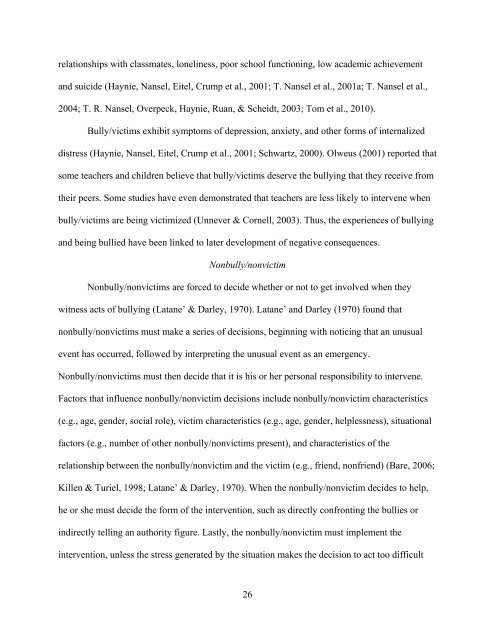Copyright Malvin Porter, Jr. 2010 - acumen - The University of ...
Copyright Malvin Porter, Jr. 2010 - acumen - The University of ...
Copyright Malvin Porter, Jr. 2010 - acumen - The University of ...
You also want an ePaper? Increase the reach of your titles
YUMPU automatically turns print PDFs into web optimized ePapers that Google loves.
elationships with classmates, loneliness, poor school functioning, low academic achievement<br />
and suicide (Haynie, Nansel, Eitel, Crump et al., 2001; T. Nansel et al., 2001a; T. Nansel et al.,<br />
2004; T. R. Nansel, Overpeck, Haynie, Ruan, & Scheidt, 2003; Tom et al., <strong>2010</strong>).<br />
Bully/victims exhibit symptoms <strong>of</strong> depression, anxiety, and other forms <strong>of</strong> internalized<br />
distress (Haynie, Nansel, Eitel, Crump et al., 2001; Schwartz, 2000). Olweus (2001) reported that<br />
some teachers and children believe that bully/victims deserve the bullying that they receive from<br />
their peers. Some studies have even demonstrated that teachers are less likely to intervene when<br />
bully/victims are being victimized (Unnever & Cornell, 2003). Thus, the experiences <strong>of</strong> bullying<br />
and being bullied have been linked to later development <strong>of</strong> negative consequences.<br />
Nonbully/nonvictim<br />
Nonbully/nonvictims are forced to decide whether or not to get involved when they<br />
witness acts <strong>of</strong> bullying (Latane’ & Darley, 1970). Latane’ and Darley (1970) found that<br />
nonbully/nonvictims must make a series <strong>of</strong> decisions, beginning with noticing that an unusual<br />
event has occurred, followed by interpreting the unusual event as an emergency.<br />
Nonbully/nonvictims must then decide that it is his or her personal responsibility to intervene.<br />
Factors that influence nonbully/nonvictim decisions include nonbully/nonvictim characteristics<br />
(e.g., age, gender, social role), victim characteristics (e.g., age, gender, helplessness), situational<br />
factors (e.g., number <strong>of</strong> other nonbully/nonvictims present), and characteristics <strong>of</strong> the<br />
relationship between the nonbully/nonvictim and the victim (e.g., friend, nonfriend) (Bare, 2006;<br />
Killen & Turiel, 1998; Latane’ & Darley, 1970). When the nonbully/nonvictim decides to help,<br />
he or she must decide the form <strong>of</strong> the intervention, such as directly confronting the bullies or<br />
indirectly telling an authority figure. Lastly, the nonbully/nonvictim must implement the<br />
intervention, unless the stress generated by the situation makes the decision to act too difficult<br />
26

















